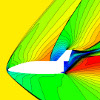Scientific Computing and Numerics (SCAN) Seminar
How should one measure the discrepancy between observed and predicted data? The traditional answer might be the Euclidean distance or a kernel-based metric. However, in this talk, I will introduce the geometric advantages of a metric motivated by optimal transport called the Wasserstein distance. I will use the Wasserstein distance to solve some challenging inverse problems that are ill-posed, high-dimensional, and susceptible to noise, where traditional optimization-based solvers are unreliable as they get stuck in local minimizers or overfit noise. The Wasserstein distance will allow us to better account for uncertainties and structural discrepancies between observed and predicted data. I will also show how optimal transport-based strategies can be integrated into machine learning pipelines for solving inverse problems with applications drawn from physics.
